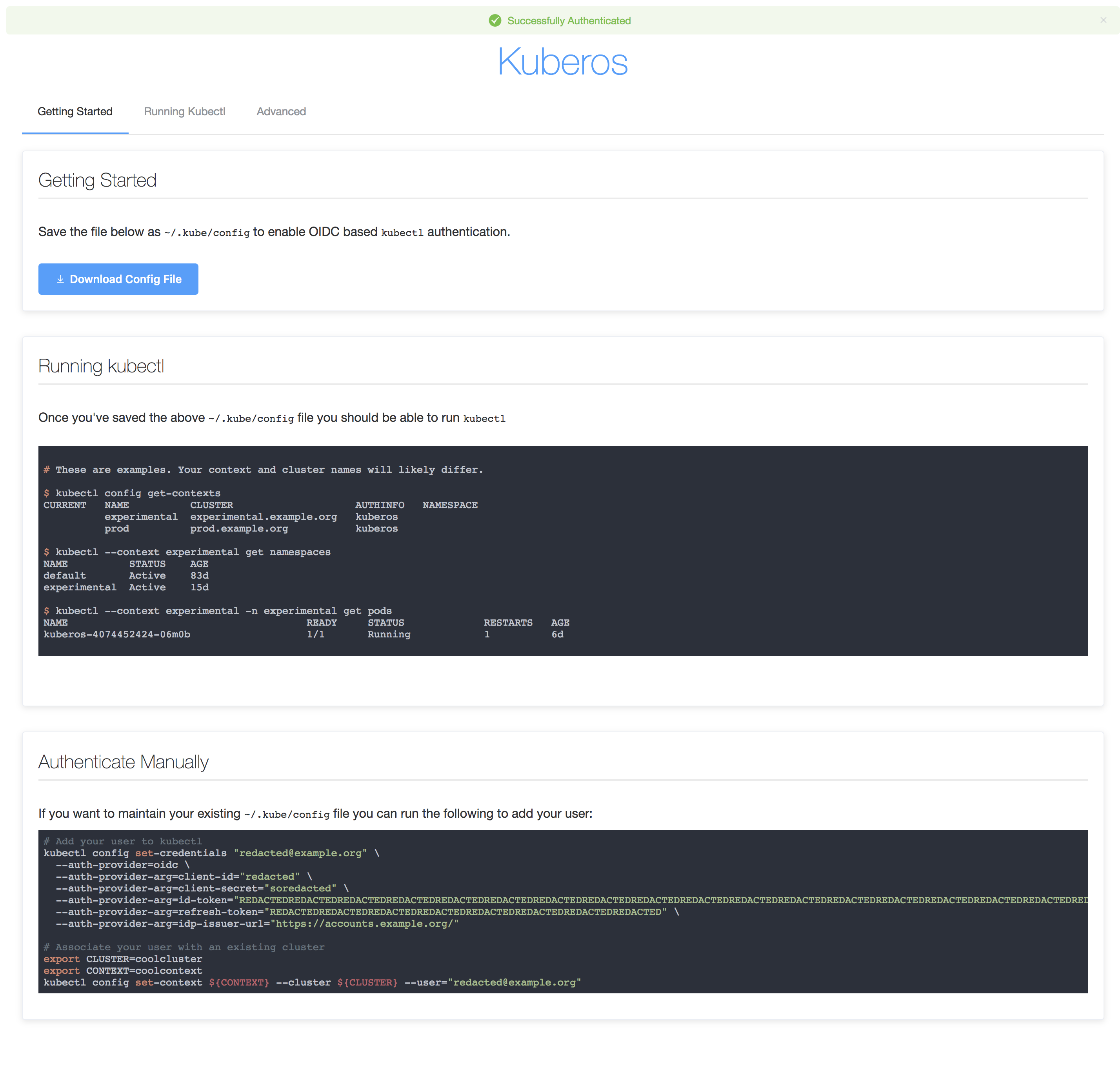kuberos 



An OIDC authentication helper for Kubernetes' kubectl.
Purpose
Kubernetes supports several authentication methods, a popular one of which is OIDC.
The kubectl commandline tool can be configured to use OIDC authentication, including
automatically refreshing its token on invocation. In order to enable this
functionality kubectl must be configured with the following parameters:
- A client ID
- A client secret
- An issuer URL
- An ID token
- A refresh token
The latter two of these parameters must be aquired by performing an initial OIDC
authentication outside of kubectl. OIDC is an awkward authentication method for a
commandline tool as it is entirely browser based. Existing implementations (see
Alternatives) provide CLI tools to handle this initial authentication. These CLIs will
typically require the user connect to localhost in their Browser to perform the initial
authentication.
Kuberos is designed to instead run as a hosted service. It authenticates users against
an OIDC provider, returning a JSON payload of the parameters required by
kubectl. Kuberos provides a simple frontend that links to a ~/.kube/config file
generated from a supplied template of clusters. It also details how to manually add a
user and context to a cluster, and how to use kubectl.
Usage
Before using Kuberos you must enable OIDC at the Kubernetes API server. Refer to this guide for details on how to get an OIDC client ID and secret from Google.
Kuberos is published to the Docker Hub.
It must be configured with an OIDC issuer, client ID, and secret, as well as a
partial kubeconfig file. For example:
export OIDC_CLIENT_ID=woo
export OIDC_CLIENT_SECRET=supersecret
echo $OIDC_CLIENT_SECRET >/tmp/cfg/secret
cat <<EOF >/tmp/cfg/template
apiVersion: v1
kind: Config
current-context: kuberos # Optional - must be the name of one of the template's clusters.
clusters:
- name: kuberos
cluster:
certificate-authority-data: REDACTED
server: https://kuberos.example.org
EOF
docker run -d -p 10003:10003 -v /tmp/cfg:/cfg "negz/kuberos:latest" \
/kuberos https://accounts.google.com $OIDC_CLIENT_ID /cfg/secret /cfg/templateKuberos supports the following arguments:
$ docker run negz/kuberos:latest /kuberos --help
usage: kuberos [<flags>] [<oidc-issuer-url>] [<client-id>] [<client-secret-file>] [<kubecfg-template>]
Provides OIDC authentication configuration for kubectl.
Flags:
--help Show context-sensitive help (also try --help-long
and --help-man).
--listen=":10003" Address at which to expose HTTP webhook.
-d, --debug Run with debug logging.
--scopes=profile... ... List of additional scopes to provide in token.
--email-domain=EMAIL-DOMAIN
The eamil domain to restrict access to.
--shutdown-grace-period=1m
Wait this long for sessions to end before
shutting down.
--shutdown-endpoint=SHUTDOWN-ENDPOINT
Insecure HTTP endpoint path (e.g., /quitquitquit)
that responds to a GET to shut down kuberos.
Args:
[<oidc-issuer-url>] OpenID Connect issuer URL.
[<client-id>] OAuth2 client ID.
[<client-secret-file>] File containing OAuth2 client secret.
[<kubecfg-template>] A kubecfg file containing clusters to populate with a user and contexts.The partial kubeconfig template should contain only cluster entries and
optionally a current (i.e. default) context, which must be the name of one of
the clusters. For example:
apiVersion: v1
kind: Config
current-context: staging
clusters:
- name: production
cluster:
certificate-authority-data: REDACTED
server: https://prod.example.org
- name: staging
cluster:
certificate-authority-data: REDACTED
server: https://staging.example.orgGiven the above template Kuberos will generate a kubeconfig file containing
the two supplied clusters, the authenticated OIDC user, and a context for each
cluster associating them with the OIDC user. These contexts inherit the name of
the clusters, thus a user could interact with the production cluster by running:
kubectl --context production cluster-infoIf the current-context is set to the name of one of the clusters then the
--context argument may be omitted, and the cluster named by current-context
will be used.
Deploying to Kubernetes
Kuberos can be run inside a cluster as long as it can still communicate with your OIDC provider from inside the pod and your OIDC provider is set to redirect to your Kuberos endpoint (NodePort, LoadBalancer, etc).
The configuration below is meant to serve as a template and not something that is plug-and-play. You will need to adjust your DNS / nameserver helpers, Dex information, and optionally how you ingress your traffic.
apiVersion: extensions/v1beta1
kind: Deployment
metadata:
labels:
app: kuberos
name: kuberos
spec:
replicas: 1
template:
metadata:
labels:
app: kuberos
spec:
# hostAliases are optional, to help route traffic to Dex / OIDC
hostAliases:
- ip: "192.168.1.1"
hostnames:
- "dex.oidc.example.com"
containers:
- image: negz/kuberos:latest
name: kuberos
command: ["/kuberos", "https://dex.oidc.example.com", "example-app", "/cfg/secret", "/cfg/template"]
ports:
- name: http
containerPort: 10003
volumeMounts:
- name: config
mountPath: /cfg
volumes:
- name: config
configMap:
name: kuberos
items:
- key: template
path: template
- key: secret
path: secret
---
kind: ConfigMap
apiVersion: v1
metadata:
name: kuberos
data:
template: |
apiVersion: v1
kind: Config
current-context: staging
clusters:
- name: production
cluster:
certificate-authority-data: REDACTED
server: https://prod.example.org
- name: staging
cluster:
certificate-authority-data: REDACTED
server: https://staging.example.org
secret: REDACTEDAlternatives
OIDC/LDAP/static helper specifically for dex (Helm charts for dex+helper included)
OIDC helpers that run locally to setup kubectl:
- https://github.com/micahhausler/k8s-oidc-helper
- https://github.com/coreos/dex/tree/master/cmd/example-app
A Kubernetes JWT webhook helper with a similar UX to Kuberos




